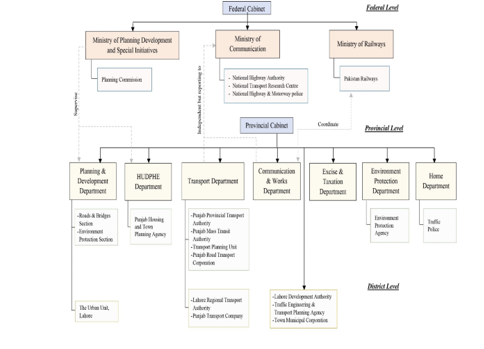Role of Transport Policies in Promoting Older Adults' Mobility: A Review of Government Policies in Pakistan
Abstract
 Abstract Views: 0
Abstract Views: 0
The current study critically reviewed government transport policies in Pakistan, focusing on their effectiveness in promoting mobility among older adults in Lahore. By examining existing institutional frameworks and policy documents, the research highlighted acute challenges to address the definite mobility needs of older adults. Findings revealed a lack of sustained, comprehensive initiatives tailored to improving elderly mobility, exacerbated by bureaucratic inefficiencies and weak coordination among institutions. Policy interventions often prioritize technical solutions over holistic approaches, considering age-related mobility constraints and societal attitudes toward aging. Additionally, older adults are entirely excluded from the policy-making process. This study suggested a paradigm shift towards inclusive transport policies that integrate age-friendly features and actively engage older adults in planning processes, thereby fostering a more accessible urban transport environment for older adults in Pakistan.
Downloads
References
Ahacic, K., Parker, M., & Thorslund, M. (2000). Mobility limitations in the Swedish population from 1968 to 1992: Age, gender and social class differences. Aging Clinical and Experimental Research, 12(3), 190–198. https://doi.org/10.1007/BF03339836
Ahmad, Z., Batool, Z., & Starkey, P. (2019). Understanding mobility characteristics and needs of older persons in urban Pakistan with respect to use of public transport and self-driving. Journal of Transport Geography, 74, 181–190. https://doi.org/10.1016/j.jtrangeo.2018.11.015
Al-Rashid, M. A., Harumain, Y. A. S., Goh, H. C., & Ahmad, Z. (2021). Psychosocial factors of public transport users and social inclusion implications among older women in Pakistan. Journal of Urban Planning and Development, 147(4), Article e04021046. https://doi.org/10.1061/(ASCE)UP.1943-5444.0000727
Al-Rashid, M. A., Harumain, Y. A. S., Goh, H. C., & Campisi, T. (2023). Psychosocial barriers to public transport use triggers older adults' social exclusion: Empirical evidence from Pakistan. Journal of Urban Planning and Development, 149(1), Article e04022050. https://doi.org/10.1061/JUPDDM.UPENG-4097
Al-Rashid, M. A., Nadeem, M., Campisi, T., Shamsul Harumain, Y. A., & Goh, H. C. (2022). How do psychosocial barriers shape public transport use? A mixed-method study among older adults in Pakistan. Sustainability, 14(19), Article e12471. https://doi.org/10.3390/su141912471
Banister, D. (2005). Unsustainable transport: City transport in the new century. Taylor & Francis.
Banister, D. (2008). The sustainable mobility paradigm. Transport Policy, 15(2), 73–80. https://doi.org/10.1016/j.tranpol.2007.10.005
Bashir, S., & Nazir, S. (2022). Burden of diseases among elderly in Pakistan. Pakistan Institute of Development Economics. https://ideas.repec.org/p/pid/kbrief/202257.html
Cheema, A. N. (2013). Upcoming picture of ageing population: Pakistan. Quality & Quantity, 47(5), 2399–2413. https://doi.org/10.1007/s11135-012-9660-0
Chodzko-Zajko, W. J., Proctor, D. N., Singh, M. A. F., Minson, C. T., Nigg, C. R., Salem, G. J., & Skinner, J. S. (2009). Exercise and physical activity for older adults. Medicine & Science in Sports & Exercise, 41(7), 1510–1530. https://doi.org/10.1249/MSS.0b013e3181a0c95c
Fan, A., & Chen, X. (2020). Exploring the relationship between transport interventions, mode choice, and travel perception: An empirical study in Beijing, China. International Journal of Environmental Research and Public Health, 17(12), 1–19. https://doi.org/10.3390/ijerph17124258
He, S. Y., Cheung, Y. H., & Tao, S. (2018). Travel mobility and social participation among older people in a transit metropolis: A socio-spatial-temporal perspective. Transportation Research Part A: Policy and Practice, 118, 608–626. https://doi.org/10.1016/j.tra.2018.09.006
Haustein, S., & Siren, A. (2014). Seniors' unmet mobility needs - how important is a driving licence? Journal of Transport Geography, 41, 45–52. https://doi.org/10.1016/j.jtrangeo.2014.08.001
Hui, V., & Habib, K. N. (2014). An investigation of transport-related social exclusion of the at-risk community (homeless people) in Toronto, Canada. National Academies. https://trid.trb.org/View/1287880
Hussain, M., & Kokab, R. U. (2012). Eighteenth amendment in the constitution of Pakistan: Success and controversies. Asian Social Science, 8(1), 81–88. http://dx.doi.org/10.5539/ass.v8n1p81
Ignaccolo, M., Inturri, G., Giuffrida, N., & Torrisi, V. (2016, November 24–25). Public transport accessibility and social exclusion: Making the connections [Paper presentation]. Proceedings of the 3rd International Conference on Traffic and Transport Engineering, Belgrade, Serbia.
Imran, M. (2009). Public transport in Pakistan: A critical overview. Journal of Public Transportation, 12(2), 53–83. https://doi.org/10.5038/2375-0901.12.2.4
Imran, M. (2010). Institutional barriers to sustainable urban transport in Pakistan. Oxford University Press.
Islam, B., Li, T., Ibrahim, T. I., Yang, D., Lv, H., Zhang, Q., Xu, M., Gassara, G., & Wang, J. (2025). The relationship between levels of physical activity, adherence to the MIND diet, and cognitive impairment in adults aged 65 years or older in Pakistan. Journal of Alzheimer's Disease Reports, 9, 1–13. https://doi.org/10.1177/25424823241290132
Kim, S. (2011). Assessing mobility in an aging society: Personal and built environment factors associated with older people's subjective transportation deficiency in the US. Transportation Research Part F: Traffic Psychology and Behaviour, 14(5), 422–429. https://doi.org/10.1016/j.trf.2011.04.011
Kenyon, S. (2011). Transport and social exclusion: Access to higher education in the UK policy context. Journal of Transport Geography, 19(4), 763–771. https://doi.org/10.1016/j.jtrangeo.2010.09.005
Krüger, F., Titz, A., Arndt, R., Groß, F., Mehrbach, F., Pajung, V., Suda, L., Wadenstorfer, M., & Wimmer, L. (2021). The Bus Rapid Transit (BRT) in Dar es Salaam: A pilot study on critical infrastructure, sustainable urban development and livelihoods. Sustainability, 13(3), Article e1058. https://doi.org/https://doi.org/10.3390/su13031058
Lin, D., & Cui, J. (2021). Transport and mobility needs for an ageing society from a policy perspective: Review and implications. International Journal of Environmental Research and Public Health, 18(22), Article e11802. https://doi.org/10.3390/ijerph182211802
Lucas, K., & Stanley, J. (2013, July 15–18). Achieving socially sustainable transport in the development context [Paper presentation]. Anais da 13th World Conference on Transport Research, Rio de Janeiro, Brazil.
Meakin, R. (1998). The Lahore public transport policy and institutions study. The World Bank.
Mercado, R., Páez, A., & Newbold, K. B. (2010). Transport policy and the provision of mobility options in an aging society: A case study of Ontario, Canada. Journal of Transport Geography, 18(5), 649–661. https://doi.org/10.1016/j.jtrangeo.2010.03.017
Metz, D. (2003). Transport policy for an ageing population. Transport Reviews, 23(4), 375–386. https://doi.org/10.1080/0144164032000048573
Olawole, M. O., & Aloba, O. (2014). Mobility characteristics of the elderly and their associated level of satisfaction with transport services in Osogbo, Southwestern Nigeria. Transport Policy, 35, 105–116. https://doi.org/10.1016/j.tranpol.2014.05.018
Patil, D. S., Bailey, A., Yadav, U. N., George, S., Helbich, M., Ettema, D., & Ashok, L. (2022). Contextual factors influencing the urban mobility infrastructure interventions and policies for older adults in low- and middle-income countries: A realist review. BMC Public Health, 22(1), 1–13. https://doi.org/10.1186/s12889-022-13875-6
Ramírez-Saiz, A., Larriva, M. T. B., Martín, D. J., & Alonso, A. (2025). Enhancing urban mobility for all: The role of universal design in supporting social inclusion for older adults and people with disabilities. Urban Science, 9(46), 1–34. https://doi.org/10.3390/urbansci9020046
Rye, T., & Carreno, M. (2008). Concessionary fares and bus operator reimbursement in Scotland and Wales: No better or no worse off? Transport Policy, 15(4), 242–250. https://doi.org/10.1016/j.tranpol.2008.06.003
Sabzwari, S. R., & Azhar, G. (2011). Ageing in Pakistan—A new challenge. Ageing International, 36(4), 423–427. https://doi.org/10.1007/s12126-010-9082-z
Simon, D. (1996). Transport and development in the Third World. Routledge
Tennakoon, V., Wiles, J., Peiris-John, R., Wickremasinghe, R., Kool, B., & Ameratunga, S. (2020). Transport equity in Sri Lanka: Experiences linked to disability and older age. Journal of Transport and Health, 18, Article e100913. https://doi.org/10.1016/j.jth.2020.100913
Tinella, L., Bosco, A., Traficante, S., Napoletano, R., Ricciardi, E., Spano, G., Lopez, A., Sanesi, G., Bergantino, A. S., & Caffò, A. O. (2023). Fostering an age-friendly sustainable transport system: A psychological perspective. Sustainability, 15(18), Article e13972. https://doi.org/10.3390/su151813972
United Nations. (2015). The world population prospects: The 2015 revision. https://www.un.org/en/development/desa/publications/world-population-prospects-2015-revision.html
Van Regenmortel, S., De Donder, L., Dury, S., Smetcoren, A.-S., De Witte, N., & Verté, D. (2016). Social exclusion in later life: A systematic review of the literature. Journal of Population Ageing, 9(4), 315–344. https://doi.org/10.1007/s12062-016-9145-3
Walsh, K., Scharf, T., & Keating, N. (2017). Social exclusion of older persons: A scoping review and conceptual framework. European Journal of Ageing, 14(1), 81–98. https://doi.org/10.1007/s10433-016-0398-8
Zhang, N., & Yang, Q. (2024). Public transport inclusion and active aging: A systematic review on elderly mobility. Journal of Traffic and Transportation Engineering, 11(2), 312–347. https://doi.org/10.1016/j.jtte.2024.04.001

Copyright (c) 2025 Muhammad Ahmad Al-Rashid, Muhammad Nadeem

This work is licensed under a Creative Commons Attribution 4.0 International License.
JAABE follows an open-access publishing policy and full text of all published articles is available free, immediately upon publication of an issue. The journal’s contents are published and distributed under the terms of the Creative Commons Attribution 4.0 International (CC-BY 4.0) license. Thus, the work submitted to the journal implies that it is original, unpublished work of the authors (neither published previously nor accepted/under consideration for publication elsewhere). On acceptance of a manuscript for publication, a corresponding author on the behalf of all co-authors of the manuscript will sign and submit a completed Copyright and Author Consent Form.
Copyright (c) The Authors





